Joint Probabilistic-Nyquist Pulse Shaping for an LDPC-Coded 8-PAM Signal in DWDM Data Center Communications
Abstract
:1. Introduction
2. Proposed PS-NPS-8-PAM-Based DWDM System
3. Simulation and Data Center Experimental Results
3.1. Simulation Results
3.2. Experimental Setup and Results
4. Conclusions
Author Contributions
Funding
Conflicts of Interest
References
- Huang, M.F.; Tanaka, A.; Ip, E.; Huang, Y.K.; Qian, D.; Zhang, Y.; Zhang, S.; Ji, P.N.; Djordjevic, I.B.; Wang, T.; et al. Terabit/s Nyquist superchannels in high capacity fiber field trials using DP-16QAM and DP-8QAM modulation formats. J. Lightwave Technol. 2014, 32, 776–782. [Google Scholar] [CrossRef]
- Perin, J.K.; Shastri, A.; Kahn, J.M. Design of Low-Power DSP-Free Coherent Receivers for Data Center Links. J. Lightwave Technol. 2017, 35, 4650–4662. [Google Scholar] [CrossRef]
- Cai, J.X.; Batshon, H.G.; Mazurczyk, M.; Zhang, H.; Sun, Y.; Sinkin, O.V.; Foursa, D.; Pilipetskii, A.N. 64QAM based coded modulation transmission over transoceanic distance with > 60Tb/s capacity. In Proceedings of the Optical Fiber Communication Conference (OFC), Los Angeles, CA, USA, 22–26 March 2015. [Google Scholar]
- Qu, Z.; Li, Y.; Mo, W.; Yang, M.; Zhu, S.; Kilper, D.; Djordjevic, I.B. Performance optimization of PM-16QAM transmission system enabled by real-time self-adaptive coding. Opt. Lett. 2017, 42, 4211–4214. [Google Scholar] [CrossRef]
- Winzer, P.J.; Neilson, D.T.; Chraplyvy, A.R. Fiber-optic transmission and networking: The previous 20 and the next 20 years. Opt. Express 2018, 26, 24190–24239. [Google Scholar] [CrossRef]
- Puttnam, B.J.; Luis, R.; Delgado-Mendinueta, J.-M.; Sakaguchi, J.; Klaus, W.; Awaji, Y.; Wada, N.; Kanno, A.; Kawanishi, T. High-capacity self-homodyne PDM-WDM-SDM transmission in a 19-core fiber. Opt. Express 2014, 22, 21185–21191. [Google Scholar] [CrossRef]
- Qu, Z.; Fu, S.; Zhang, M.; Tang, M.; Shum, P.; Liu, D. Analytical investigation on self-homodyne coherent system based on few-mode fiber. IEEE Photonics Technol. Lett. 2014, 26, 74–77. [Google Scholar] [CrossRef]
- Puttnam, B.J.; Luís, R.S.; Mendinueta, J.M.D.; Sakaguchi, J.; Klaus, W.; Kamio, Y.; Nakamura, M.; Wada, N.; Awaji, Y.; Kanno, A.; et al. Self-homodyne detection in optical communication systems. Photonics 2014, 1, 110–130. [Google Scholar] [CrossRef]
- Zhong, K.; Zhou, X.; Gao, Y.; Chen, W.; Man, J.; Zeng, L.; Lau, A.P.T.; Lu, C. 140-Gb/s 20-km Transmission of PAM-4 Signal at 1.3 μm for Short Reach Communications. IEEE Photonics Technol. Lett. 2015, 27, 1757–1760. [Google Scholar] [CrossRef]
- Eiselt, N.; Wei, J.; Griesser, H.; Dochhan, A.; Eiselt, M.; Elbers, J.-P.; Olmos, J.J.V.; Monroy, I.T. First real-time 400G PAM-4 demonstration for inter-data center transmission over 100 km of SSMF at 1550 nm. In Proceedings of the Optical Fiber Communications Conference and Exhibition (OFC), Anaheim, CA, USA, 20–24 March 2016. [Google Scholar]
- Mestre, M.A.; Mardoyan, H.; Konczykowska, A.; Rios-Müller, R.; Renaudier, J.; Jorge, F.; Duval, B.; Dupuy, J.-Y.; Ghazisaeidi, A.; Jennevé, P.; et al. Direct detection transceiver at 150-Gbit/s net data rate using PAM 8 for optical interconnects. In Proceedings of the 2015 European Conference on Optical Communication (ECOC), Valencia, Spain, 27 September–1 October 2015. [Google Scholar]
- Chen, B.; Okonkwo, C.; Hafermann, H.; Alvarado, A. Increasing achievable information rates via geometric shaping. In Proceedings of the European Conference on Optical Communication (ECOC), Rome, Italy, 23–27 September 2018. [Google Scholar]
- Qu, Z.; Djordjevic, I.B.; Anderson, J. Two-Dimensional Constellation Shaping in Fiber-Optic Communications. Appl. Sci. 2019, 9, 1889. [Google Scholar] [CrossRef]
- Khandani, A.K.; Kabal, P. Shaping multidimensional signal spaces. I. Optimum shaping, shell mapping. IEEE Trans. Inf. Theory 1993, 39, 1799–1808. [Google Scholar] [CrossRef]
- Qu, Z.; Djordjevic, I.B. Geometrically shaped 16QAM outperforming probabilistically shaped 16QAM. In Proceedings of the European Conference on Optical Communication (ECOC), Gothenburg, Sweden, 17–21 September 2017. [Google Scholar]
- Forney, G.D. Trellis shaping. IEEE Trans. Inf. Theory 1992, 38, 281–300. [Google Scholar] [CrossRef]
- Forney, G.D.; Wei, L.-F. Multidimensional constellations—Part I: Introduction, figures of merit, and generalized cross constellations. IEEE J. Sel. Areas Commun. 1989, 7, 877–892. [Google Scholar] [CrossRef]
- Cho, J.; Chen, X.; Chandrasekhar, S.; Raybon, G.; Dar, R.; Schmalen, L.; Burrows, E.; Adamiecki, A.; Corteselli, S.; Pan, Y.; et al. Trans-atlantic field trial using high spectral efficiency probabilistically shaped 64-QAM and single-carrier real-time 250-Gb/s 16-QAM. J. Lightware Technol. 2018, 36, 103–113. [Google Scholar] [CrossRef]
- Calderbank, A.R.; Ozarow, L.H. Non-equiprobable signaling on the Gaussian channel. IEEE Trans. Inf. Theory 1990, 36, 726–740. [Google Scholar] [CrossRef]
- Qu, Z.; Djordjevic, I.B. On the Probabilistic Shaping and Geometric Shaping in Optical Communication Systems. IEEE Access 2019, 7, 21454–21464. [Google Scholar] [CrossRef]
- Steiner, F.; Böcherer, G. Comparison of Geometric and Probabilistic Shaping with Application to ATSC 3.0. In Proceedings of the International ITG Conference on Systems, Communications and Coding (SCC), Hamburg, Germany, 6–9 February 2017. [Google Scholar]
- Fehenberger, T.; Alvarado, A.; Bocherer, G.; Hanik, N. On probabilistic shaping of quadrature amplitude modulation for the nonlinear fiber channel. J. Lightware Technol. 2016, 34, 5063–5073. [Google Scholar] [CrossRef]
- Böcherer, G.; Steiner, F.; Schulte, P. Bandwidth efficient and rate-matched low-density parity-check coded modulation. IEEE Trans. Commun. 2015, 63, 4651–4665. [Google Scholar] [CrossRef]
- Qu, Z.; Djordjevic, I.B. Hybrid Probabilistic-Geometric Shaping in Optical Communication Systems. In Proceedings of the IEEE Photonics Conference (IPC), Reston, VA, USA, 30 September–4 October 2018. [Google Scholar]
- Batshon, H.G.; Mazurczyk, M.V.; Cai, J.X.; Sinkin, O.V.; Paskov, M.; Davidson, C.R.; Wang, D.; Bolshtyansky, M.; Foursa, D. Coded modulation based on 56APSK with hybrid shaping for high spectral efficiency transmission. In Proceedings of the 2017 European Conference on Optical Communication (ECOC), Gothenburg, Sweden, 17–21 September 2017. [Google Scholar]
- Ren, J.; Liu, B.; Xu, X.; Zhang, L.; Mao, Y.; Wu, X.; Zhang, Y.; Jiang, L.; Xin, X. A probabilistically shaped star-CAP-16/32 modulation based on constellation design with honeycomb-like decision regions. Opt. Express 2019, 27, 2732–2746. [Google Scholar] [CrossRef]
- Han, X.; Yang, M.; Djordjevic, I.B. Hybrid Probabilistic-Geometric-Shaped 8-PAM Suitable for Data Centers’ Communication. In Proceedings of the Asia Communications and Photonics Conference (ACP), Hangzhou, China, 26–29 October 2018. [Google Scholar]
- Qu, Z.; Lin, C.; Liu, T.; Djordjevic, I.B. Experimental study of nonlinearity tolerant modulation formats based on LDPC coded non-uniform signaling. In Proceedings of the Optical Fiber Communications Conference and Exhibition (OFC), Los Angeles, CA, USA, 19–23 March 2017. [Google Scholar]
- Yankovn, M.P.; Ros, F.D.; Silva, E.P.; Forchhammer, S.; Larsen, K.J.; Oxenløwe, L.K.; Galili, M.; Zibar, D. Constellation Shaping for WDM Systems Using 256QAM/1024QAM with Probabilistic Optimization. J. Lightware Technol. 2016, 34, 5146–5156. [Google Scholar] [CrossRef]
- Gallager, R.G. Information Theory and Reliable Communication; Wiley: Hoboken, NJ, USA, 1968. [Google Scholar]
- Schulte, P.; Bocherer, G. Constant composition distribution matching. IEEE Trans. Inf. Theory 2016, 62, 430–434. [Google Scholar] [CrossRef]
- Fehenberger, T.; Millar, D.S.; Koike-Akino, T.; Kojima, K.; Parsons, K. Multiset-partition distribution matching. IEEE Trans. Commun. 2018, 67, 1885–1893. [Google Scholar] [CrossRef]
- Han, X.; Djordjevic, I.B. Probabilistically shaped 8-PAM suitable for data centers communication. In Proceedings of the International Conference on Transparent Optical Networks (ICTON), Bucharest, Romania, 1–5 July 2018. [Google Scholar]
- Eriksson, T.A.; Chagnon, M.; Buchali, F.; Schuh, K.; Brink, S.T.; Schmalen, L. 56 Gbaud Probabilistically Shaped PAM8 for Data Center Interconnects. In Proceedings of the 2017 European Conference on Optical Communication (ECOC), Gothenburg, Sweden, 17–21 September 2017. [Google Scholar]
- Sun, L.; Wang, C.; Du, J.; Liang, C.; Zhang, W.; Xu, K.; Zhang, F.; He, Z. Dyadic Probabilistic Shaping of PAM-4 and PAM-8 for Cost-Effective VCSEL-MMF Optical Interconnection. IEEE Photonics J. 2019, 11, 1–12. [Google Scholar] [CrossRef]
- Lu, P.; Zhang, L.; Liu, X.; Yao, J.; Zhu, Z. Highly efficient data migration and backup for big data applications in elastic optical inter-data-center networks. IEEE Netw. 2015, 29, 36–42. [Google Scholar] [CrossRef]
- Mahimkar, A.; Chiu, A.; Doverspike, R.; Feuer, M.D.; Magill, P.; Mavrogiorgis, E.; Pastor, J.; Woodward, S.L.; Yates, J. Bandwidth on Demand for Inter-Data Center Communication. In Proceedings of the 10th ACM Workshop on Hot Topics in Networks (HotNets-X’11), New York, NY, USA, 14–15 November 2011; ACM: New York, NY, USA, 2011. [Google Scholar]
- Chen, K.; Singla, A.; Singh, A.; Ramachandran, K.; Xu, L.; Zhang, Y.; Wen, X.; Chen, Y. OSA: An Optical Switching Architecture for Data Center Networks with Unprecedented Flexibility. IEEE/ACM Trans. Netw. 2014, 22, 498–511. [Google Scholar] [CrossRef]
- Hirai, R.; Kikuchi, N.; Fukui, T. High-spectral efficiency DWDM transmission of 100-Gbit/s/lambda IM/DD single sideband-baseband-Nyquist-PAM8 signals. In Proceedings of the Optical Fiber Communications Conference and Exhibition (OFC), Los Angeles, CA, USA, 19–23 March 2017. [Google Scholar]
- Yue, Y.; Wang, Q.; Anderson, J. Transmitter skew tolerance and spectral efficiency tradeoff in high baud-rate QAM optical communication systems. Opt. Express 2018, 26, 15045–15058. [Google Scholar] [CrossRef]

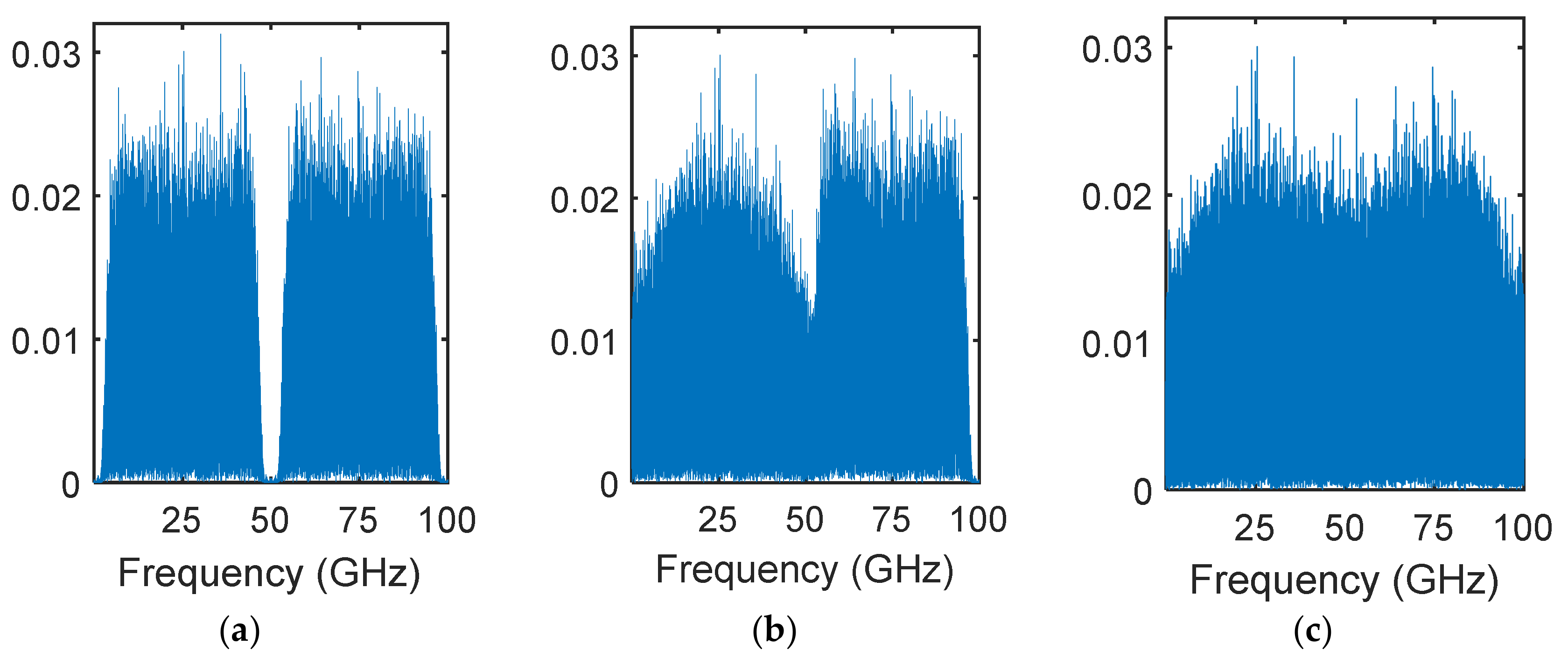
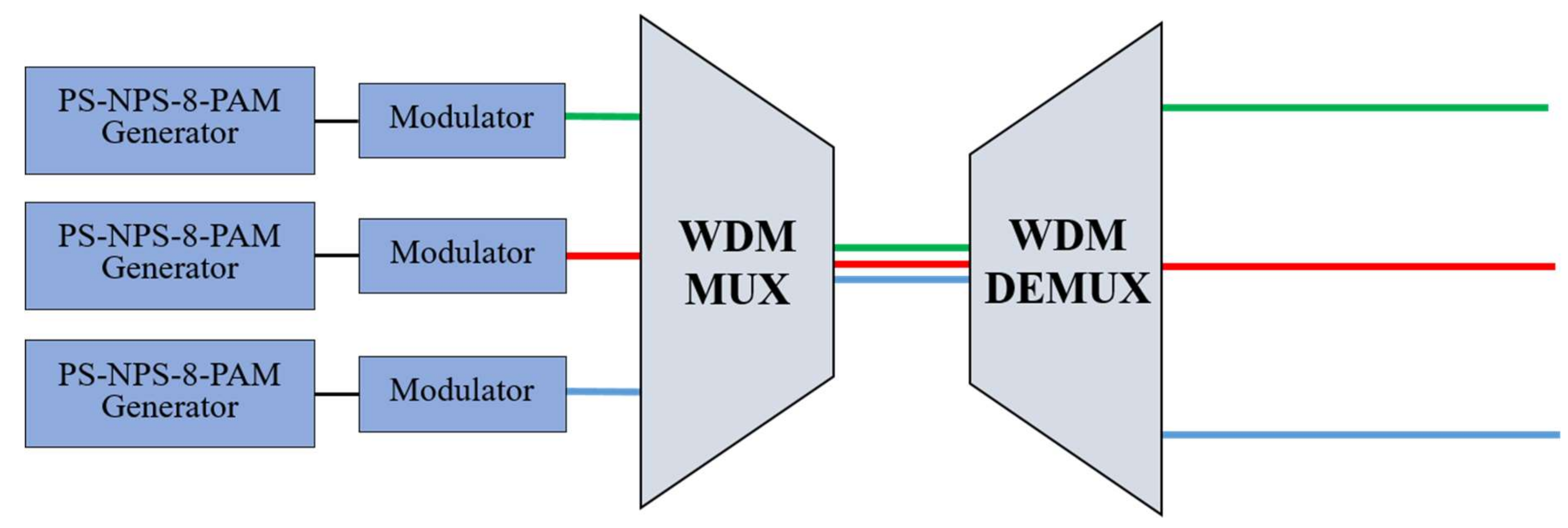
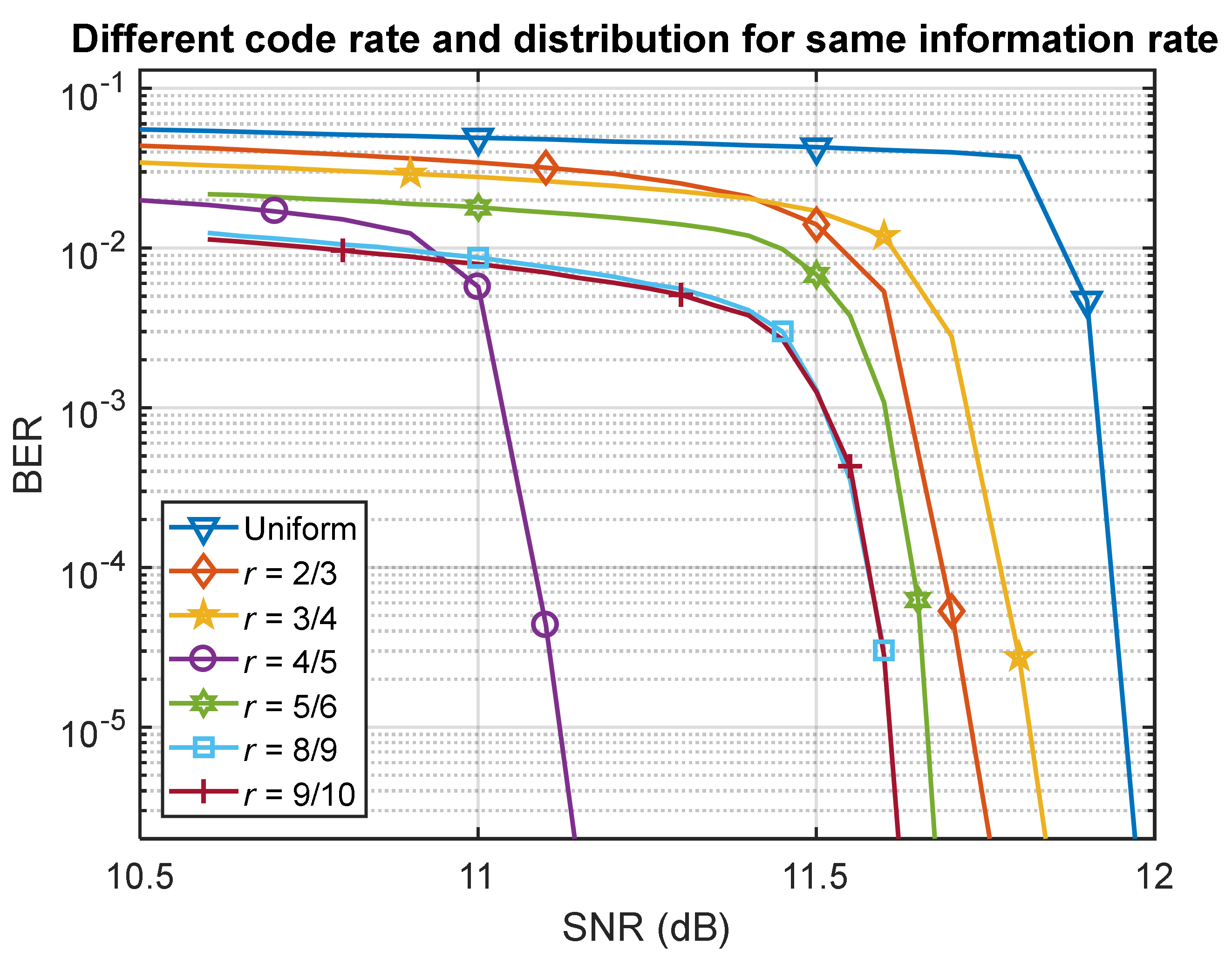
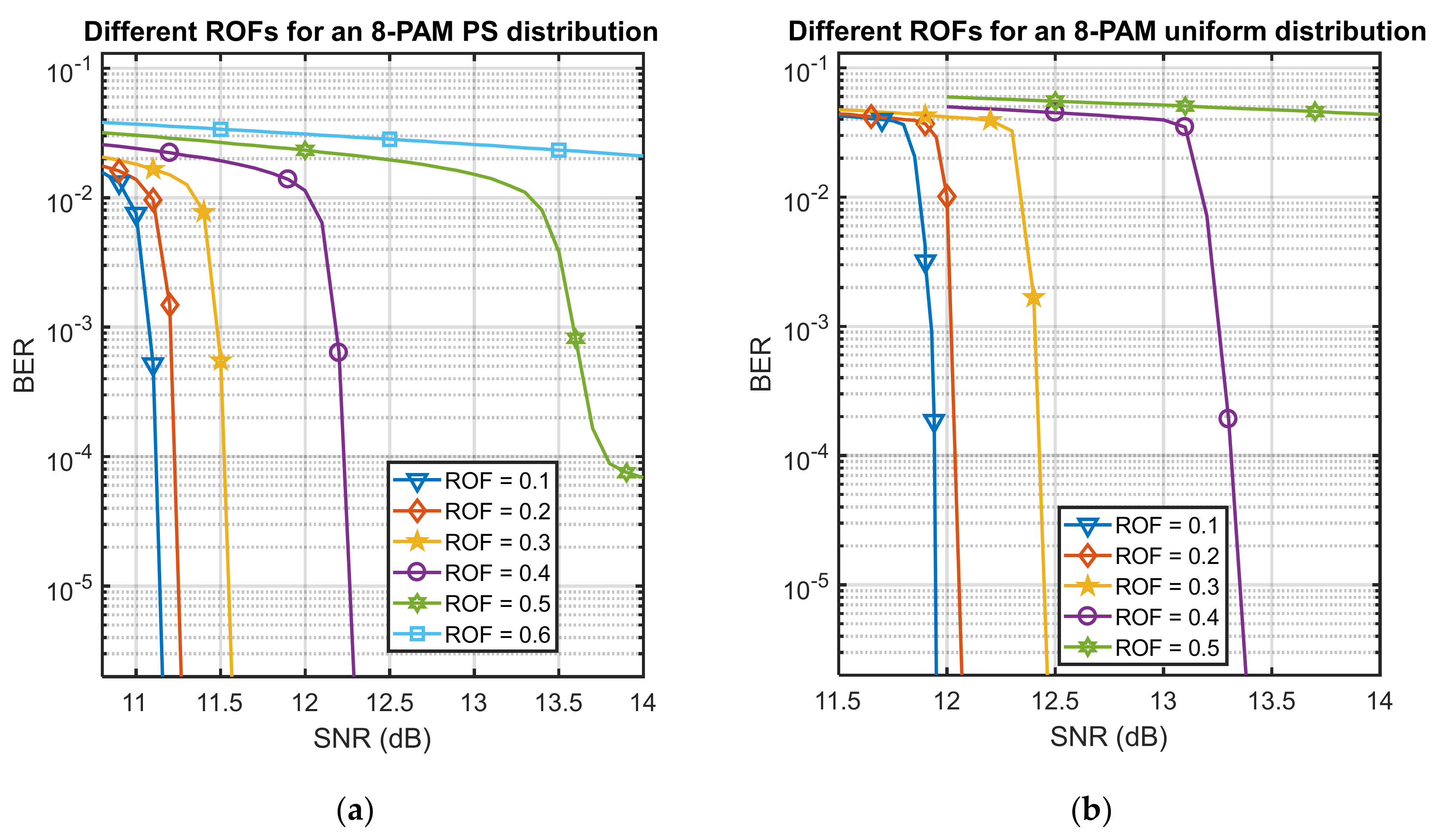
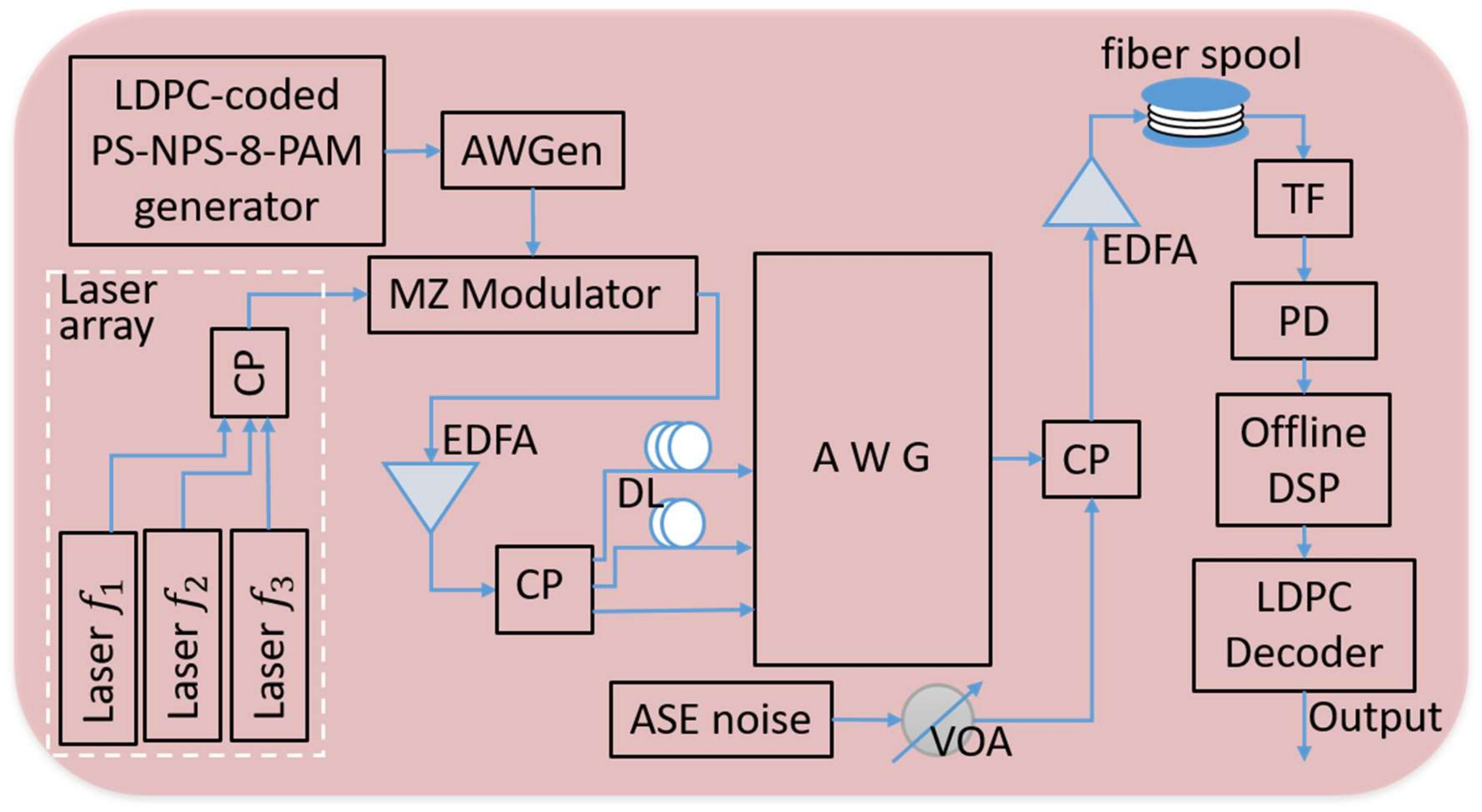
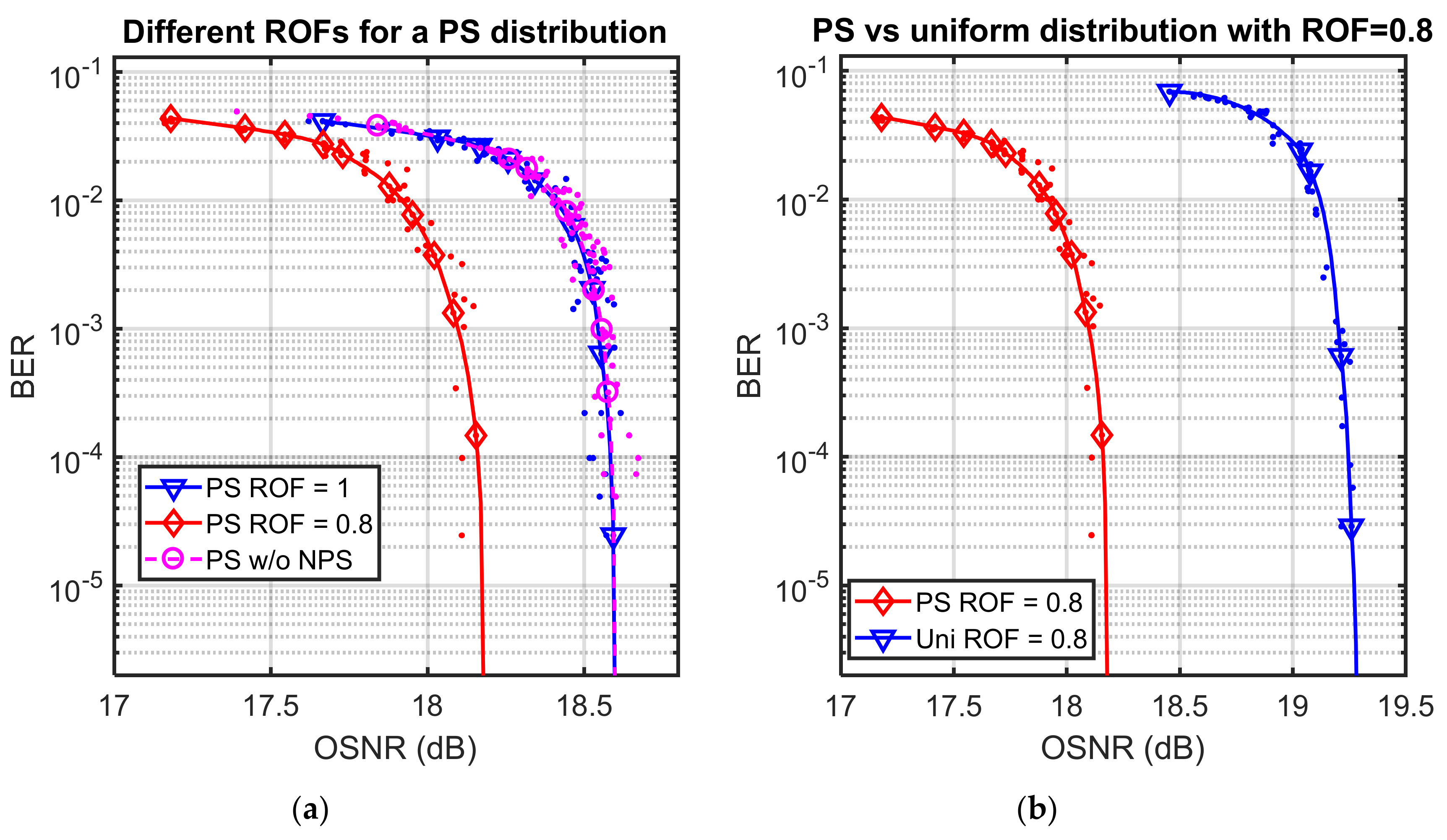
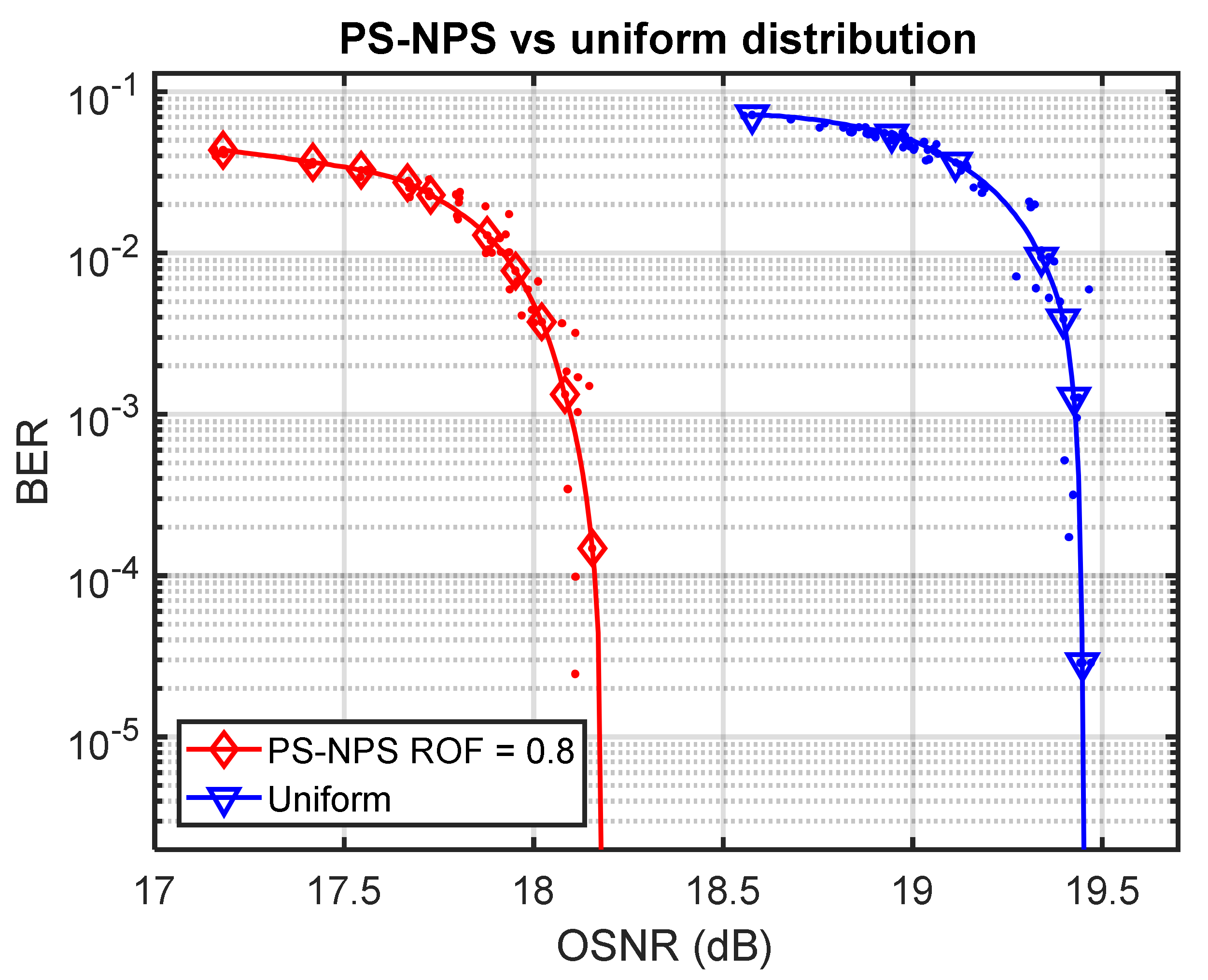
© 2019 by the authors. Licensee MDPI, Basel, Switzerland. This article is an open access article distributed under the terms and conditions of the Creative Commons Attribution (CC BY) license (http://creativecommons.org/licenses/by/4.0/).
Share and Cite
Han, X.; Yang, M.; Djordjevic, I.B.; Yue, Y.; Wang, Q.; Qu, Z.; Anderson, J. Joint Probabilistic-Nyquist Pulse Shaping for an LDPC-Coded 8-PAM Signal in DWDM Data Center Communications. Appl. Sci. 2019, 9, 4996. https://doi.org/10.3390/app9234996
Han X, Yang M, Djordjevic IB, Yue Y, Wang Q, Qu Z, Anderson J. Joint Probabilistic-Nyquist Pulse Shaping for an LDPC-Coded 8-PAM Signal in DWDM Data Center Communications. Applied Sciences. 2019; 9(23):4996. https://doi.org/10.3390/app9234996
Chicago/Turabian StyleHan, Xiao, Mingwei Yang, Ivan B. Djordjevic, Yang Yue, Qiang Wang, Zhen Qu, and Jon Anderson. 2019. "Joint Probabilistic-Nyquist Pulse Shaping for an LDPC-Coded 8-PAM Signal in DWDM Data Center Communications" Applied Sciences 9, no. 23: 4996. https://doi.org/10.3390/app9234996
APA StyleHan, X., Yang, M., Djordjevic, I. B., Yue, Y., Wang, Q., Qu, Z., & Anderson, J. (2019). Joint Probabilistic-Nyquist Pulse Shaping for an LDPC-Coded 8-PAM Signal in DWDM Data Center Communications. Applied Sciences, 9(23), 4996. https://doi.org/10.3390/app9234996







